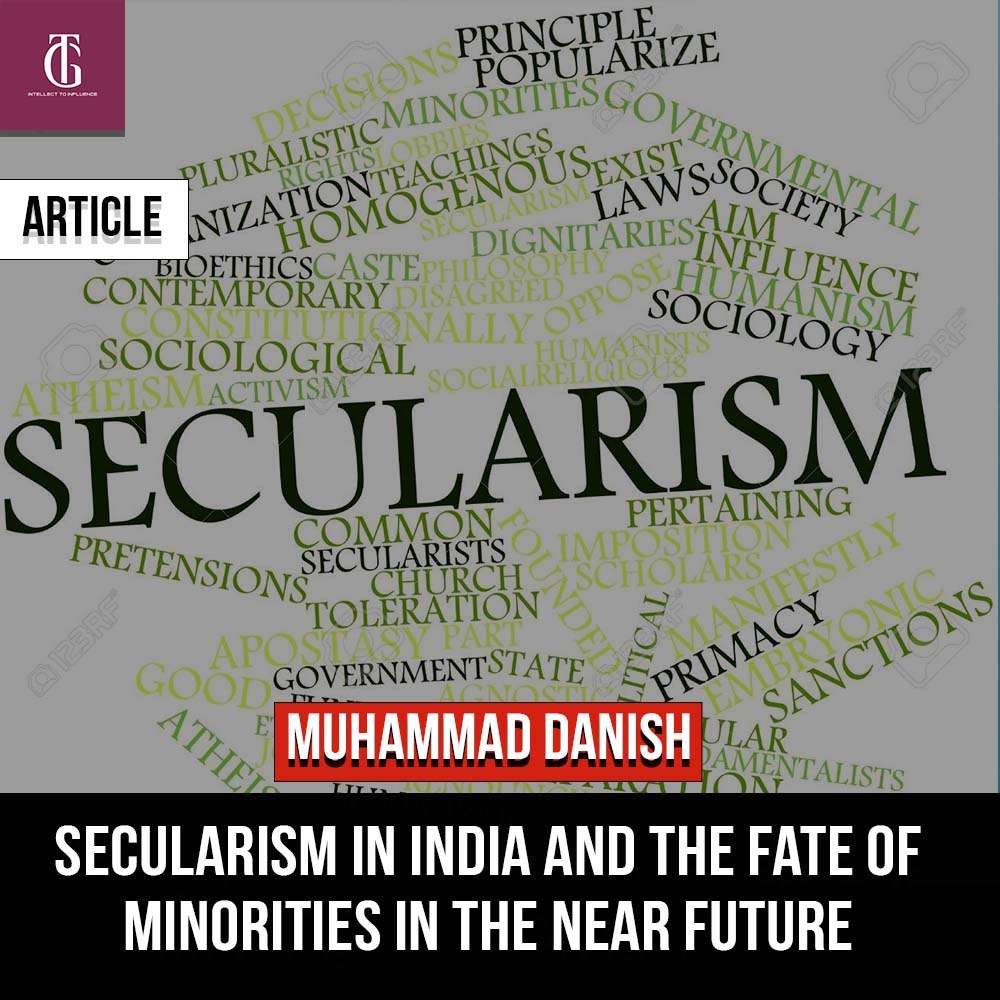
Is India truly a secular state, as mentioned in its constitution? What are the contradictions between the principles of secularism and BJP’s Hindutva ideology? How did the BJP’s campaign strategies in the 2024 election leverage Hindutva? George Jacob Holyoake, an English social reformer and writer, is credited with coining the term “secularism” in 1851. Holyoake defined secularism as “a code of duty pertaining to this life, founded on considerations purely human and intended mainly for those who find theology indefinite or inadequate or insupportable. (Holyoake, G. J. 1872)
The belief is that religion should not be involved with the ordinary social and political activities of the country. Secularism is a principle that involves two basic propositions. The first is the strict separation of the state from religious institutions. The second is that before the law the people of different religions and beliefs are equal.
The term ‘secularization’ was used in 1648 at the end of the Thirty Years War in Europe, to refer to the transfer of properties of the Church to the exclusive control of the princes. Again on November 2, 1989, after the French Revolution, Charles Maurice de Talleyrand announced to the French National Assembly that all ecclesiastical goods were at the dispersal of the nation. Later in 1851, George Jack Holyoake coined the term ‘Secularism’ and led a national movement of protest. The idea of secularization was built into the idea of progress. Secularization, though nowhere more than a fragmenting and incomplete process, however since retained a positive consolation. (Chishti, 2004).
However, the explanation and application of secularism in India have been subject to debate and criticism due to various socio-political factors. Some scholars argue that Indian secularism is practiced by “principled distance” rather than having strict separation of religious and state affairs, that allow the state intervention in religious matters to promote social justice and equality (Chatterjee, 1994).
Moreover, the practice of secularism in India has faced several challenges, especially in the context of communal riots and politics based on identity. There are instances in which the scholars pointed out, that political parties, mainly the ruling Bharatiya Janata Party (BJP), exploit religious sentiments for electoral support, leading to polarization among religious communities (Jaffrelot, 2019).
After the subcontinent’s independence, India despite being a multicultural, multiethnic, and multireligious state, managed to survive despite huge diversity within the state. The leader of India’s independence Jawaharlal Nehru, and the ruling political party Indian National Congress advocated for a new brand of secularism i.e., Indian secularism designed to hold the country’s diverse communities together under a single flag. After the Indian constitution (in 1950) was formulated, according to Articles 25 and 26 India was declared as a secular state, where all persons are equally entitled to freedom of conscience and the right freely to profess, practice, and propagate religion, and they have freedom to manage religious affairs, respectively. Also, Nehru often addressed that the diverse cultures are the strength of Indian society. (Jaffrelot, 2019)
Between the 1950s and the 1970s, India’s secular model seemed to work well. Religious minorities, including Muslims, etc., remained well-represented in the country’s elected assemblies. Furthermore, communal riots were relatively less during that period; to counter communalism, Nehru sought to prevent Indian politicians from exploiting the religious sentiments of all communities, just for the sake of political gains and sanctioned those who promoted religious divide. It was even included in the Indian Constitution of 1950, according to Section 123 of the Representation of the People Act of 1951, the law that guides the conduct of elections in India, forbids politicians from campaigning on religious themes for this reason. (Representation of the People Act, 1951)
The Bharatiya Janata Party (BJP), which is one of the prominent political parties in India, supports the ideology of Hindutva, according to that, it is a nationalist ideology that is rooted in the cultural and religious identity of Hinduism. Hindutva, as articulated by thinkers like Vinayak Damodar Savarkar and later popularized by organizations like the Rashtriya Swayamsevak Sangh (RSS), the ideological wellspring of Hindu nationalism—murdered Mahatma Gandhi in 1948, seeks to assert Hindu cultural and political dominance in Indian society (Jaffrelot, 2019).
Hindutva (literally “Hindu-ness”) is a modern political ideology that advocates for Hindu Nationalism, and Hindu supremacy and seeks to transform India, which is constitutionally a secular state, into an ethno-religious nation known as the Hindu Rashtra (Hindu nation). Hindutva is the official platform of the BJP, which is an extreme-right political party in India.
Hindutva ideology demeans many groups and individuals, and the supporters of Hindutva often resort to violence to achieve their objectives. Muslims are often the primary targets of those who support Hindutva ideology. Many human rights organizations have documented a rise in anti-Muslim violence since 2014, when the BJP came to national power in India. Hindutva ideologues are also often intolerant of other religious communities like Christians, media journalists, people from lower castes and Dalits, Adivasis, and women. In the disputed region of Kashmir, Hindutva ideology is carrying out a settler-colonial project that is objective to transform the demographics of the Muslim-majority region.
vBut after the election of 2014, Bharatiya Janata Party the Hindu Nationalist Party gained victory by a large margin, BJP claimed India was a majoritarian nation-state, not a multicultural and religious state, and the party started nominating Muslims as the invaders who came from the middle east settle in India, exploited the native Hindus community and ruled for about hundreds of years.
BJP’s leader and Indian Prime Minister is accused of delivering a hateful speech against Muslims addressing Muslims as “infiltrators” While addressing a convention “Muslims have the first right over the nation’s wealth, it will be distributed among those who have more children. It will be distributed to the infiltrators. Do you think your hard-earned money should be given to infiltrators? Would you accept this?” These were the remarks against the specific community (Muslims). (Times, New York 2024).
A few days back an animated video was posted on othe BJP’s official social media account, in which it portrayed that the opposition party congress planted an egg outside of India and spent all the resources on it consequently ousting the native eggs from the nest. (India’s animated video wars cause stir on the campaign trail, 2024).
The hatred that spread through this election campaign, is illegal according to the Indian constitution The Representation of People Act, 1951 will lead Indian society to the verge of chaos.
What will be the outcome of speech and animated videos? Most probably it will increase the hatred between the communities, strengthen the Hindus anti-muslim sentiments that will lead to the communal violence to such a level that it will affect the Indian society to a such a level that Indian secular society will crumble and India will become a majoritarian nation-state, where the minorities will have no rights.
Narendra Modi the Prime Minister of India, he himself delivered the hate speeches had a rich impact of Hindu society minds as a strong leader of Indian politics, this will encourage the violent Hindu mobs to cross the line of rule of law easily, as it was seen in the past that those Hindus, which were involved in these riots against communities other than Hindu were released without any punishment from the Indian courts. Law and order for the violent mobs that targeted minorities is not the same, they got easily bailed out, and their cases dismissed in no time.
According to India crime branch statistical data from 2017 to December 2022, there were 2900 riots incidents were registered and this number is increasing day by day, India is losing is tag of a secular state in the last two tenures of BJP’s represented Narendra Modi. The incident of Hindu mod attack on Babari Masjid and Muslims lost legal case of it and building of Ram Mandar on its place, were supported by RSS and BJP. Such incidents are leading India from a secular state to a Hindu majority nation state, where the minorities will no be safe and their future generation will be in real trouble.
References
- Holyoake, G. J. (1872). The Principles of Secularism: A Very Short Introduction
- Chishti, S. M. A. W. (2004). SECULARISM IN INDIA: AN OVERVIEW. The Indian Journal of Political Science, 65(2), 183–198. http://www.jstor.org/stable/41855808.
- Chatterjee, Partha. “Secularism and Toleration.” Economic and Political Weekly, vol. 29, no. 28, 1994, pp. 1768–77. JSTOR, http://www.jstor.org/stable/4401459. Accessed 9 May 2024.
- Chatterji, Angana P., Thomas Blom Hansen, and Christophe Jaffrelot (eds), Majoritarian State: How Hindu Nationalism is Changing India (2019; online edn, Oxford Academic, 20 Feb. 2020), https://doi.org/10.1093/oso/9780190078171.001.0001. accessed 9 May 2024.
- The Representation of People Act, 1951 – other resources – Election Commission of India (no date) Government of India, Ministry of Law and Justice, Legislative Department. Available at: https://old.eci.gov.in/files/file/15137-the-representation-of-people-act-1951/. (Accessed: 09 May 2024).
- Jaffrelot, C. (2019). Majoritarian State: How Hindu Nationalism is Changing India. Oxford University Press.
- Jaffrelot, C. (2019) The fate of secularism in India – the BJP in power: Indian democracy and Religious Nationalism, Carnegie Endowment for International Peace. Available at: https://carnegieendowment.org/2019/04/04/fate-of-secularism-in-india-pub-78689. (Accessed: 09 May 2024).
- Modi calls Muslims ‘infiltrators’ in a speech during India elections (2024) The New York Times. Available at: https://www.nytimes.com/video/world/asia/100000009428303/modi-muslims-india-election.html. (Accessed: 09 May 2024).
- France 24 (2024) ‘India’s animated video wars cause stir on the campaign trail’, 5 May. Available at: https://www.france24.com/en/asia-pacific/20240505-india-s-animated-video-wars-cause-stir-on-the-campaign-trail (Accessed: 09 May 2024).
Human Rights Watch. (2021). World Report 2021: India Events of 2020 https://www.hrw.org/world-report/2021/country-chapters/india.

Muhammad Danish
Muhammad Danish, a student of Bs Political Science at School.of Politics and International Relations Quaid I Azam University.





